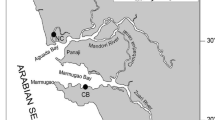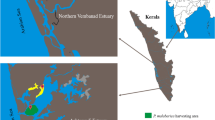Abstract
The major beds of oyster along the central-west coast of India are exposed to different anthropogenic activities and are severely exploited for human consumption. In this viewpoint, tissues of oyster Crassostrea madrasensis, C. gryphoides and Saccostrea cucullata were analyzed for Cu, Ni, Cd and Pb concentrations (dry weight) from Chicalim Bay, Nerul Creek and Chapora Bay in pre-monsoon, monsoon and post-monsoon seasons. A higher concentration of Cu (134.4–2167.9 mg kg−1) and Cd (7.1–88.5 mg kg−1) was found, which is greater than the recommended limits in all the three species (and sites). Moreover, significant (p < 0.05) variations were observed for all the metals concentrations among the species, seasons and sites. The high concentrations of Cd and Cu in tissues of edible oyster pose a threat to human health. Therefore, continuous monitoring, people awareness and a stringent government policy should be implemented to mitigate the metal pollution along the studied sites.


Similar content being viewed by others
References
Alagarsamy R (2006) Distribution and seasonal variation of trace metals in the surface sediments of the Mandovi Estuary, West coast of India. Estuar Coast Shelf Sci 67:333–339
Amiard JC, Amiard-Triquet C, Charbonnier L, Mesnil A, Rainbow PS, Wang WX (2008) Bioaccessibility of essential and non-essential metals in commercial shellfish from Western Europe and Asia. Food Chem Toxicol 46:2010–2022
Asha KK, Anandan R, Mathew S, Lakshmanan PT (2014) Biochemistry Biochemical profile of oyster Crassostrea madrasensis and its nutritional attributes. Egypt J Aquat Res 40:35–41
Belivermis M, Warnau M, Metian M, Oberhansli F, Teyssie JL, Lacoue-Labarthe T (2015) Limited effects of increased CO 2 and temperature on metal and radionuclide bioaccumulation in a sessile invertebrate, the oyster Crassostrea gigas. ICES J Mar Sci. doi:10.1093/icesjms/fsv236
Boyden CR, Phillips DJH (1981) Seasonal and inherent variability of trace elements in oysters and their implications for indicator studies. Mar Ecol Prog Ser 5:29–40
Cheng WW, Gobas FA (2007) Assessment of human health risks of consumption of cadmium contaminated cultured oysters. Human Ecol Risk Assess 13(2):1–13
Cheung YH, Wong MH (1992) Trace metal contents of the pacific oyster (Crassostrea gigas) purchased from markets in Hong Kong. Environ Manag 16(6):753–761
Engel DW, Fowler BA (1979) Factors influencing cadmium accumulation and its toxicity to marine organisms. Environ Health Perspect 28:81–88
European Union (EU) (2001) Commission Regulation as regards heavy metals. Directive 2001/22/EC, No. 466/2001
FAO (1983) Compilation of legal limits for hazardous substances in fish and fishery products. Food and Agriculture Organization of the United Nations, Rome, FAO Fishery Circular No. 464, pp 5–100
Gorman M (1993) Environmental hazards: marine pollution. ABC-CLIO, Santa Barbara
Huanxin W, Lejun Z, Presley BJ (2000) Bioaccumulation of heavy metals in oyster (Crassostrea virginica) tissue and shell. Environ Geol 39(11):1216–1226
Hung TC, Han BC (1990) Copper availability and assimilative capacity in sea water along the charting coastal area. Counc Agric Fish Ser 23:221–229
Kessarkar PM, Shynu R, Rao VP, Chong F, Narvekar T, Zhang J (2013) Geochemistry of the suspended sediment in the estuaries of the Mandovi and Zuari Rivers, Central west coast of India. Environ Monit Assess 185:4461–4480. doi:10.1007/s10661-012-2883-7
Kumari LK, Kaisary S, Rodrigues V (2006) Bioaccumulation of some trace metals in the short-neck clam Paphia malabarica from Mandovi estuary, Goa. Environ Int 32:229–234
Laxmi Priya S, Senthilkumar B, Hariharan G, Paneer Selvam A, Purvaja R, Ramesh R (2010) Bioaccumulation of heavy metals in mullet (Mugil cephalus) and oyster (Crassostrea madrasensis) from Pulicat Lake, south east coast of India. Toxicol Ind Health 27(2):117–126. doi:10.1177/0748233710381892
National Aquaculture Sector Overview-India, Food and Agriculture Organization of the United Nations. http://www.fao.org/fishery/countrysector/naso_india/en. Accessed 2 March 2016
Parson TR, Maita Y, Lalli CM (1984) A manual of chemical and biological methods for seawater analysis. Pregamon press, Oxford
Prajith A, Rao VP, Chakraborty P (2016) Distribution, provenance and early diagenesis of major and trace metals in sediment cores from the Mandovi estuary, western India. Estuar Coast Shelf Sci 170:173–185
Rainbow PS (2002) Trace metal concentrations in aquatic invertebrates: why and so what? Environ Pollut 120:497–507
Sarkar SK, Bhattacharya B, Debnath S (1994) The suitability of tropical marine bivalves as biomonitors of heavy metals in deltaic sundarbans, north-east India. Chemosphere 29(4):759–770
UNEP (1993) United National Environment Program: Environmental Data Report. UNEP, Oxford
USFDA (1993) Food and drug administration, Guidance document for nickel in shell fish. DHHS/PHS/FDA/CFSAN/office of seafood, USFDA Washington
Veerasingam S, Vethamony P, Mani Murali R, Fernandes B (2015) Depositional record of trace metals and degree of contamination in core sediments from the Mandovi estuarine mangrove ecosystem, west coast of India. Mar Pollut Bull 91:362–367
Zvinowanda CM, Okonkwo JO, Shabalala PN, Agyei NM (2009) A novel adsorbent for heavy metal remediation in aqueous environments. Int J Environ Sci Technol 6(3):425–434
Acknowledgments
The authors are thankful to S.W.A. Naqvi, Director, CSIR-NIO for his encouragement and providing all facilities to carry out this work. We are also grateful to Dr. B. N. Nath for providing chemicals and laboratory facilities for sample analysis. The first author would like to acknowledge Council of Scientific and Industrial Research (CSIR), India for providing the fellowship to carry out the Ph.D. research. We thank the anonymous reviewers for their insightful comments on the manuscript. This is NIO contribution no. 5954.
Author information
Authors and Affiliations
Corresponding author
Rights and permissions
About this article
Cite this article
Shenai-Tirodkar, P.S., Gauns, M.U. & Ansari, Z.A. Concentrations of Heavy Metals in Commercially Important Oysters from Goa, Central-West Coast of India. Bull Environ Contam Toxicol 97, 813–819 (2016). https://doi.org/10.1007/s00128-016-1956-7
Received:
Accepted:
Published:
Issue Date:
DOI: https://doi.org/10.1007/s00128-016-1956-7




